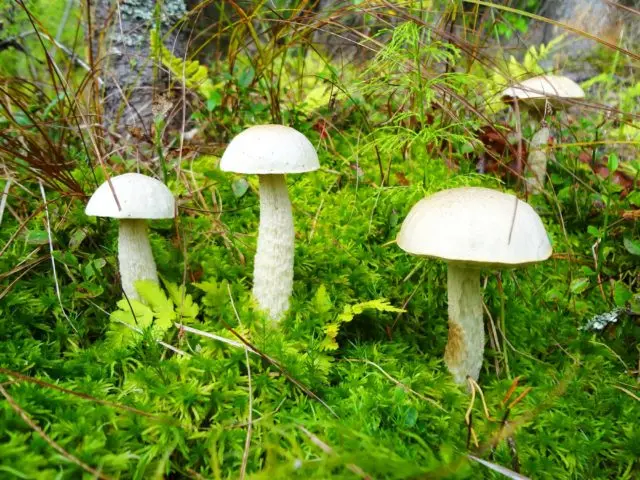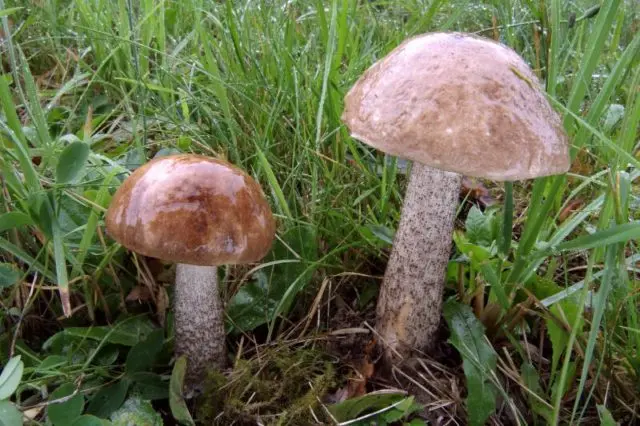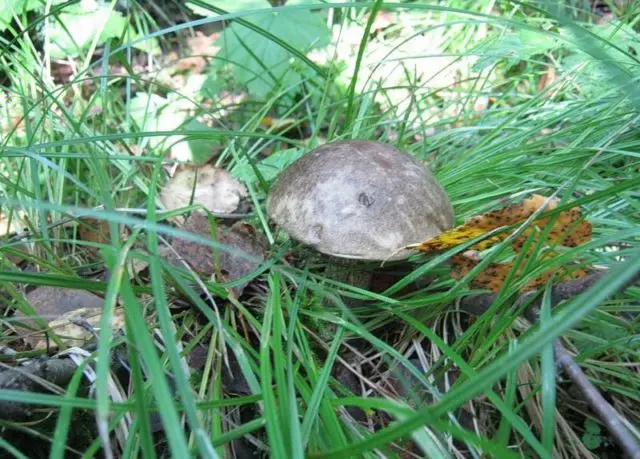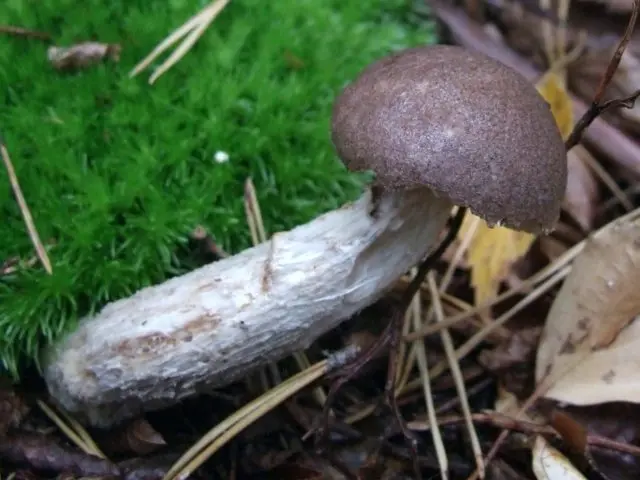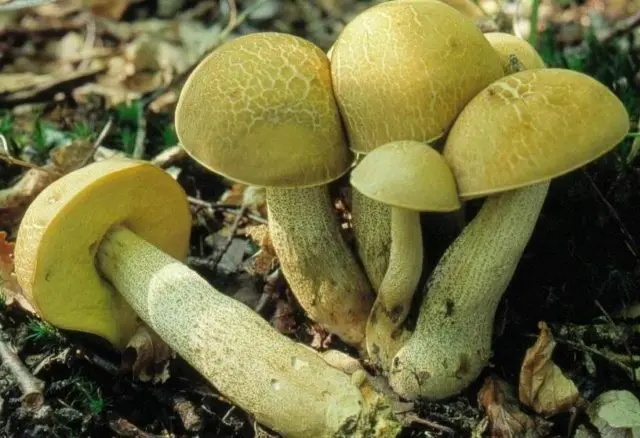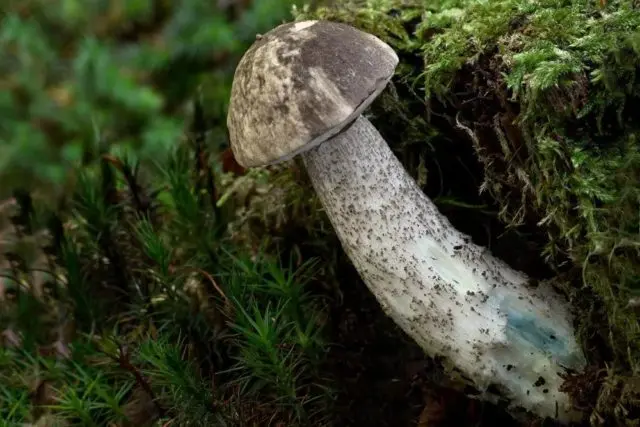Contents
- Why is the mushroom called boletus
- Types of boletus
- What does a boletus mushroom look like
- Features of the structure of the boletus
- Where do birch trees grow
- How much boletus mushrooms grow
- When are boletus harvested
- How to distinguish a gall fungus from a boletus
- Boletus edible mushroom or not
- The taste of the mushroom
- Benefits and harm to the body
- Use
- Conclusion
A photo of a boletus mushroom must be studied by every mushroom picker, this mushroom is considered one of the most delicious and delicious. It is quite easy to remember the external features of the boletus and find it in the forest.
Why is the mushroom called boletus
The name of the mushroom is deciphered very easily, boletus, or simply birch, is most often found next to birches. It forms a symbiosis, or mycorrhiza, with the roots of this tree, although it can also grow close to other trees.
In addition, a certain similarity with birch can be seen in the structure of the fungus itself, its leg is covered with longitudinal dark-colored scales, somewhat reminiscent of stripes on birch trees.
Boletus is also called simply birch in another way. Sometimes you can see it under the name obabka, such a word comes from the dialectical word “baba”, meaning “stump”, and is especially common in the Arkhangelsk and Pskov regions. Accordingly, the word “babok” simply means a mushroom that grows next to a stump, or “with a woman.”
Types of boletus
In Our Country, boletus can be found in several varieties, except for the common one. It would be more correct to say that under this name many types of boletus are combined with a photo and description, which differ in color and place of growth, but have similarities in structure.
It is useful to know their features to find out when found in the forest:
- Black. The fruit body is slightly smaller than that of an ordinary birch, its hat is darker, brown, the flesh quickly turns blue when broken.
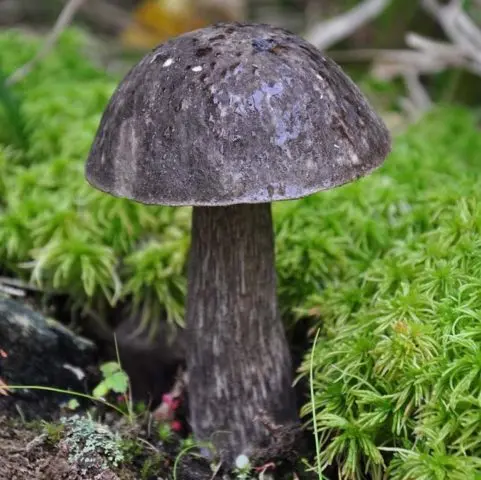
- White. The fungus grows mainly in swamps and mossy shady forests, it is distinguished by a light hat with almost white scales.

- pinking. You can recognize it by a thin curved leg and a gray-brown or brown color. A characteristic feature of the turning pink birch is that its flesh on the cut does not turn blue from contact with air, but acquires a pinkish tint.

- Gray. In color and structure, it looks like a common boletus, has a velvety brownish or olive-brown hat of a hemispherical shape.

- Harsh, or poplar. In appearance, it looks like an ordinary birch, in the center of the cap in adult mushrooms there may be a small depression. A characteristic feature of the harsh birch is hard pulp.

- blackening. It is distinguished by a yellow-brown cap and a lemon-yellow tubular layer, on the cut it becomes purple, and then black.

- Variegated. An unusual birch tree has a variegated gray-brown hat, as if covered with frequent strokes.

The study of varieties of boletus allows you to correctly recognize unusual, but edible mushrooms and put them in the basket.
What does a boletus mushroom look like
The boletus belongs to mushrooms, which are quite easy to recognize in appearance. His cap is convex, in the shape of a hemisphere, reaches 15 cm in diameter. The surface of the cap is dull and dry, and the shade can be gray, brown-brown or almost black, depending on the variety and growing conditions of the fungus. On the underside, the cap is white at a young age, becoming grayish-brown as it matures, the surface is spongy.
The leg of the boletus is light beige, yellowish or brownish, dense and slightly thickened towards the base. In height, it reaches an average of 15 cm, covered with dark longitudinal stripes-scales, they allow you to unmistakably recognize a birch fungus.
If you break a birch tree in half, then its flesh will turn out to be white, it will either not change its color in the air, or it will acquire a bluish or pinkish tint. The structure of the pulp is dense, but in adult mushrooms it becomes loose.
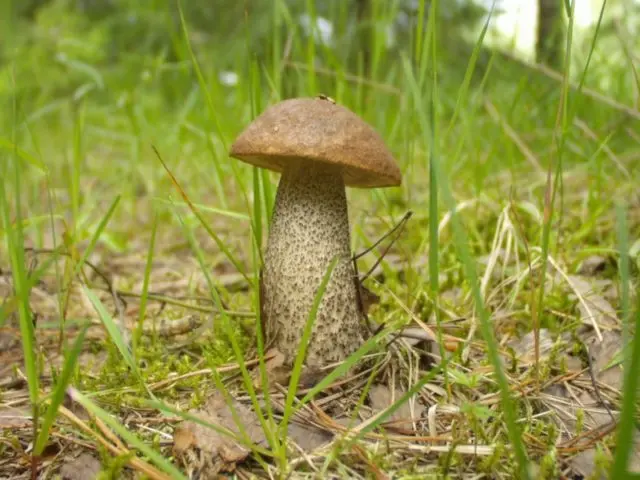
Features of the structure of the boletus
Outwardly, a birch at a young age can resemble a porcini mushroom in its shape and shade of a hat. But it is easy to recognize him by his leg. It is the boletus that is characterized by small gray and black scales, which are arranged in a longitudinal order and make the leg a bit like a birch trunk.
The structural features of the fungus largely depend on the place of growth. So, birch trees growing in light and dry forests usually have thick and dense legs, while those that appear in damp places and on the outskirts of swamps have tall, thin and lighter legs.
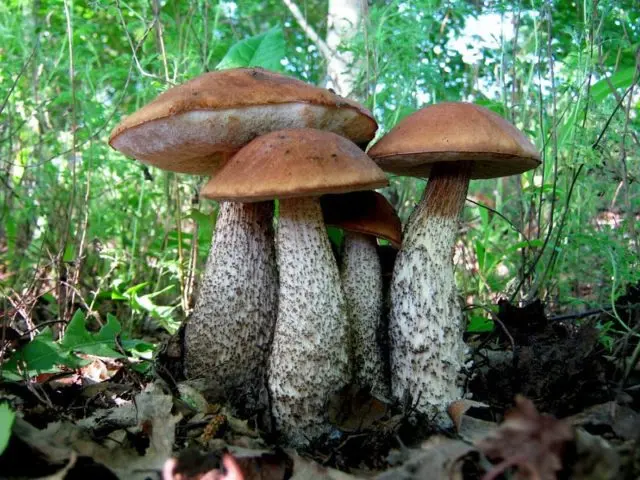
Where do birch trees grow
You can find an edible mushroom almost throughout Our Country. The fungus grows in the middle lane, is found in Siberia and the Far East, in the northern regions. There is also a birch tree in the subtropics – it can be found in the Caucasus and in the Crimea.
Most often, birch is found in birch forests directly near birches, boletus supplies the roots of the tree with nutrients and itself receives important compounds from it. You can also find it in any deciduous and mixed forests, on the edges and on the edge of glades, near ravines. Birch prefers calcareous soils, but can grow on other types of soil.
How much boletus mushrooms grow
A characteristic feature of birch trees is the very rapid growth of fruiting bodies. In just a day, they add about 4 cm in height and gain up to 10 g of weight.
When are boletus harvested
Edible mushrooms appear quite early, already at the end of May, and grow until October and the first frosts. It is recommended to collect them during the period of the highest fruiting, from July to September, when a maximum of young and fresh fruiting bodies is observed in the forests.
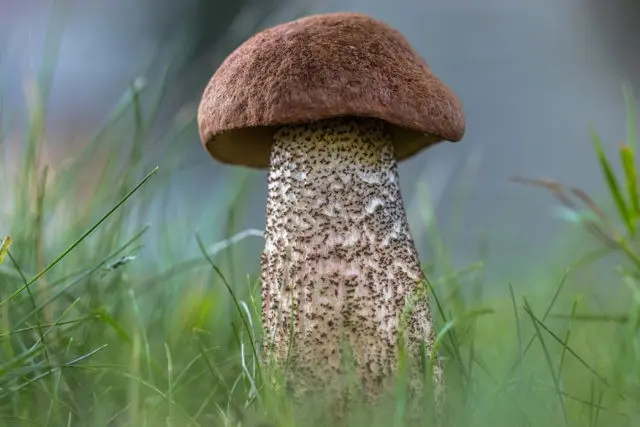
How to distinguish a gall fungus from a boletus
Thanks to the characteristic photo and description of the boletus mushroom, it has practically no false twins. However, sometimes it can be confused with mustard, or gall fungus.
The species are similar to each other in the following ways:
- in the form of a cap, in both it is hemispherical and convex, with a spongy lower surface, consisting of many small tubules;
- in color – dark brown, gray, light brown, brownish, yellow-brown for both mushrooms;
- on the leg – dense, fleshy and slightly thickened in the lower part near the surface of the earth.
However, mushrooms also have significant differences, namely:
- the leg of the mustard is not covered with longitudinal scales, like that of a birch, but with larger branched veins resembling vessels;
- even in a young gall fungus, the tubules on the underside of the cap are yellowish, and if you cut off the tubular layer, it will quickly turn red from interaction with air;
- the upper side of the cap of boletus is smooth, while that of mustards is slightly velvety and does not smooth out when touched in wet weather.
In addition, the gall fungus is never touched by worms and forest insects, unlike birch, it is not suitable for them to eat.
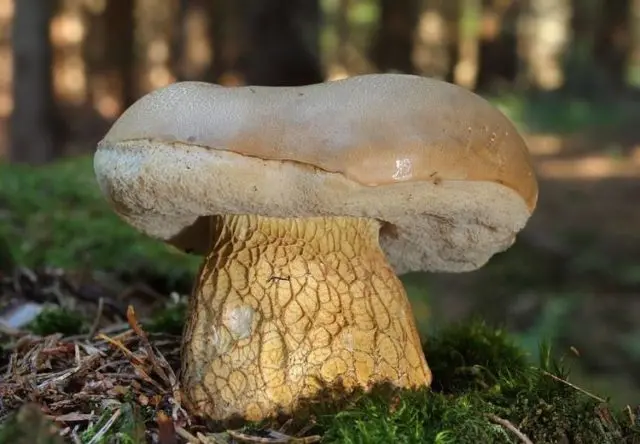
Boletus edible mushroom or not
According to the description of the boletus mushroom, it is completely edible and belongs to the delicacy category. You can eat both caps and legs. True, among mushroom lovers, the latter are much more valued for their ability to maintain their shape and structure. If the hats become soft after cooking and many do not like the consistency, then the legs retain a pleasant fortress.
The taste of the mushroom
Boletus is considered one of the most delicious mushrooms. Not without reason, during autumn trips to the forest, finding it is considered a great success for a mushroom picker. The mushroom retains a pleasant taste in all forms after any processing – boiling, frying and pickling.
Benefits and harm to the body
When eaten, boletus is not only able to please with a pleasant taste. It has a valuable composition, since its pulp contains:
- fats and carbohydrates;
- cellulose;
- vitamins B1 and B2;
- ascorbic acid;
- vitamins E and PP;
- potassium and manganese;
- a huge amount of easily digestible vegetable proteins;
- calcium;
- iron, sodium and phosphorus;
- magnesium.
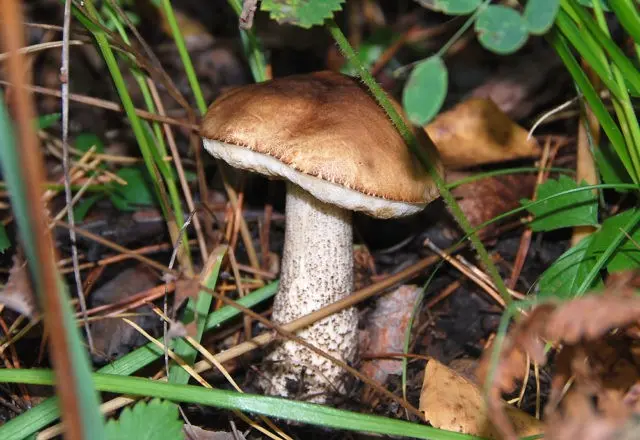
At the same time, the calorie content of birch is only 20 kcal per 100 g; with its high nutritional value, it can be considered a dietary product.
Due to the chemical composition of the boletus mushroom, its use has a beneficial effect on the human body.
In particular, he:
- helps to remove toxins from the body, because it has absorbent properties;
- supports healthy liver and kidney function;
- regulates sugar levels and is very useful for diabetics;
- prevents the development of beriberi and anemia, the use of birch provides the body with iron, vitamins and valuable trace elements;
- can serve as a substitute for animal protein in the diet, it will be especially useful for vegetarians;
- supports the normal functioning of the heart and vascular system;
- increases immune resistance due to vitamin C and other important substances;
- brings a good effect when dieting, because it does not contribute to weight gain, but perfectly saturates.
Of course, even the delicacy boletus has certain contraindications. The fungus can be damaged primarily with individual intolerance, it is quite rare, but it exists. Also, you should not use mushroom pulp for chronic diseases of the stomach and intestines and during exacerbations – birch is hard to digest and can worsen the condition.
Use
The culinary use of boletus mushrooms is very extensive – these mushrooms are classified as universal and are suitable for any cooking method. Fruit bodies are fried and boiled, pickled and dried, added to soups and salads.
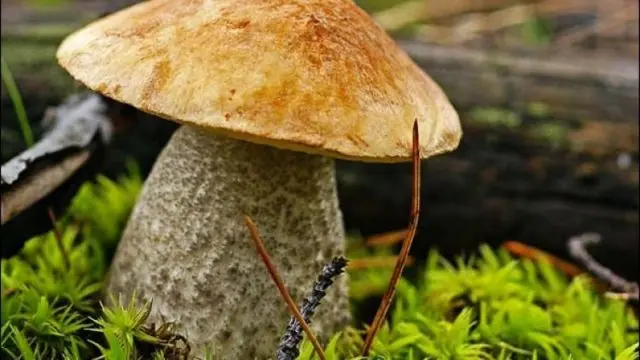
Although the bolete is a fully edible mushroom, it must be processed before cooking. First of all, the fruiting body is cleaned of plant debris and adhering earth, the skin is peeled off and the leg is cut off at the bottom. After that, the mushroom is washed in cold water.
Unlike many other mushrooms, birch mushrooms do not require soaking. However, putting it in water with the addition of lemon juice for at least half an hour is necessary – this will prevent the pulp from turning blue. The prepared birch is boiled twice, first boiled for 5 minutes after boiling, and then they change the water and cook for another half an hour along with a whole onion, bay leaf and a couple of peppercorns. Boiled boletus mushrooms can be fried with vegetables, added to salads and side dishes, or marinated.
The medical use of the product also deserves mention. Since the composition of the birch contains a lot of useful substances, many ailments are treated with it. For example, tinctures with the use of boletus are used to treat gout and osteochondrosis as rubbing. Taking tinctures inside has a positive effect on the state of the reproductive system, and home remedies with the addition of boletus have an analgesic and sedative effect.
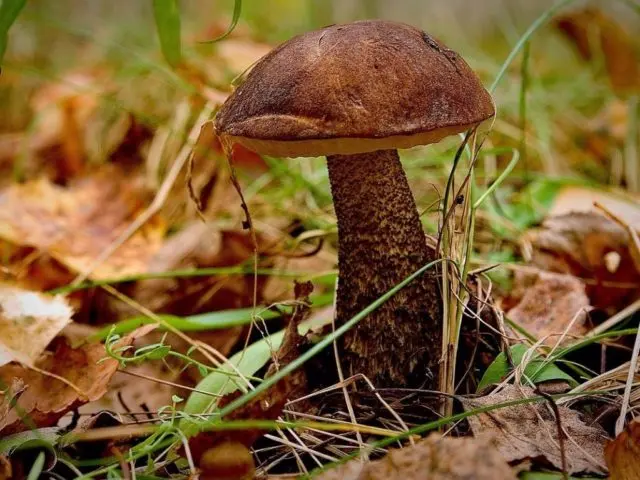
Conclusion
A photo of a boletus mushroom is very easy to remember, this edible mushroom has very characteristic external features, although the size and shade of some varieties may differ. You can eat birch tree without fear, it does not contain any toxic substances and is very useful for the body.










